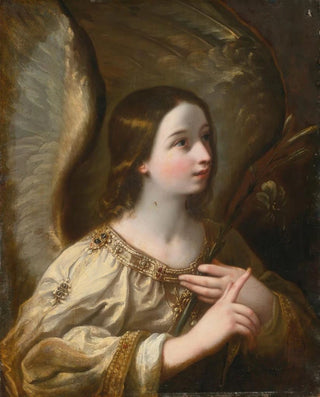Art print | Angel of the Annunciation - Circle of Guido Reni


View from behind

Frame (optional)
The Annunciation Angel - Circle of Guido Reni – Captivating Introduction
The Annunciation Angel, an iconic work by the Circle of Guido Reni, embodies a sublime encounter between the divine and the human. This art print, enchanting with its beauty and spiritual depth, transports us to the heart of the Italian Renaissance, a period where art and faith intertwine with remarkable intensity. In this piece, the angel, celestial messenger, is depicted with an ethereal grace, a characteristic that has left an indelible mark of Reni on art history. The soft light and delicate colors emanating from this work invite contemplation, awakening in us a reflection on transcendence and divine beauty.
Style and uniqueness of the work
The style of the Circle of Guido Reni is distinguished by unparalleled technical mastery and refined artistic sensitivity. The Annunciation Angel is characterized by flowing lines and a rendering of drapery that evokes an almost airy lightness. The faces, imbued with profound serenity, are treated with finesse that reveals subtle emotions of the characters. The color palette, dominated by pastel tones and golden highlights, creates a gentle and soothing atmosphere, conducive to meditation. This work does not merely depict a biblical moment; it transcends time and space, inviting the viewer to a unique spiritual experience. The balanced composition, where each element finds its place in harmony, reflects a thoughtful consideration of beauty and symmetry, values dear to the Renaissance.
The artist and his influence
Guido Reni, a central figure of Italian Baroque, knew how to mark his era with his innovative approach and inimitable style. Trained in Bologna, he was influenced by great masters of painting, such as Carracci and Michelangelo, but developed a distinctive aesthetic, combining classicism and Baroque sensitivity. His work not only shaped the artistic landscape of his time but also left a lasting imprint on subsequent generations. Artists who followed in his footsteps have often sought to capture the

Matte finish

View from behind

Frame (optional)
The Annunciation Angel - Circle of Guido Reni – Captivating Introduction
The Annunciation Angel, an iconic work by the Circle of Guido Reni, embodies a sublime encounter between the divine and the human. This art print, enchanting with its beauty and spiritual depth, transports us to the heart of the Italian Renaissance, a period where art and faith intertwine with remarkable intensity. In this piece, the angel, celestial messenger, is depicted with an ethereal grace, a characteristic that has left an indelible mark of Reni on art history. The soft light and delicate colors emanating from this work invite contemplation, awakening in us a reflection on transcendence and divine beauty.
Style and uniqueness of the work
The style of the Circle of Guido Reni is distinguished by unparalleled technical mastery and refined artistic sensitivity. The Annunciation Angel is characterized by flowing lines and a rendering of drapery that evokes an almost airy lightness. The faces, imbued with profound serenity, are treated with finesse that reveals subtle emotions of the characters. The color palette, dominated by pastel tones and golden highlights, creates a gentle and soothing atmosphere, conducive to meditation. This work does not merely depict a biblical moment; it transcends time and space, inviting the viewer to a unique spiritual experience. The balanced composition, where each element finds its place in harmony, reflects a thoughtful consideration of beauty and symmetry, values dear to the Renaissance.
The artist and his influence
Guido Reni, a central figure of Italian Baroque, knew how to mark his era with his innovative approach and inimitable style. Trained in Bologna, he was influenced by great masters of painting, such as Carracci and Michelangelo, but developed a distinctive aesthetic, combining classicism and Baroque sensitivity. His work not only shaped the artistic landscape of his time but also left a lasting imprint on subsequent generations. Artists who followed in his footsteps have often sought to capture the






